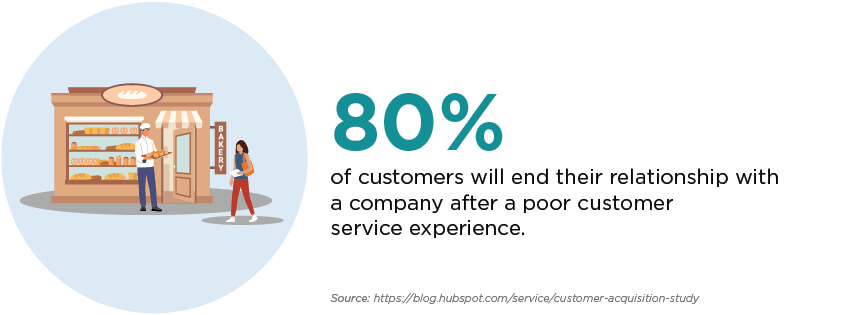What business wouldn’t like to increase sales? Even the most successful businesses mustn’t lose sight of their revenue drivers, or they could risk letting the competition sneak up on them.
To boost sales, you need a solid sales strategy. The good news is that a strong strategy starts with simple sales tactics. Just remember: Though they’re simple, these practices do require effort and focus. You’ve got this.
10 Ways to Increase Sales

Generating sales starts with understanding your customers and providing excellent customer service. You can then increase sales with strategic marketing and an effective sales team.
1. Understand why customers buy.
Before you can sell anything, you must understand why your customers need it—how will it help them or improve their lives?
When you understand your customers’ motives for buying, you can choose advertising channels that reach them where they are and at the right time. You can also generate ideas for improving products and services or adding complementary products that not only serve your customers but create upsell opportunities.
So, when a potential customer considers your product or service, ask yourself what brought them to that point. Are they looking for a better way to do something? Or a product with superior performance or extra features? Maybe they’ve had a bad customer experience somewhere else, or perhaps they need an entirely new way of doing something. In some cases, they may have a problem they can’t even identify until your strategic marketing educates them.
2. Understand what customers want.
The foundation of an effective sales strategy can be reinforced with a deeper understanding not just of what customers need, but also what they want.
Someone may need a way to listen to podcasts on a plane without disturbing other passengers, but they might want more than that. While the simple $3 earbuds sold by flight attendants will do the job, a customer may also want comfort, noise cancellation and durability. Because a different product delivers what they want and not just what they need, that customer is willing to invest more.
The key is discovering which factors of your product or service fulfill your customer’s desires and inspire them to buy from your business instead of your competitors.
3. Focus on excellent customer service.
The importance of customer service cannot be overstated, especially in an age when customer reviews and referrals can make or break your business.
A record of great customer service will pave the way for new customers while fostering long-term loyalty to keep your current customers coming back for more. In this way, excellent customer service both increases sales and keeps your customer acquisition costs down.

Even an outstanding product will struggle to overcome a horrible customer experience. In fact, while 78% of customers will forgive a business for a mistake after they receive excellent customer service, 80% will end their relationship with a company after a poor customer service experience.
Deliver a great customer experience by asking for and responding to customer feedback. When necessary, make changes and communicate your efforts. This will help you develop a deeper connection with your customers and demonstrate that they matter to your business.
4. Understand your place in the market.
You don’t sell in a silo, and your competitors might be making all the same claims as you. That’s why it’s essential to analyze how your offering fits into the market—and to define how it’s unique.
What is your value proposition? It could relate to your product, your customer service, your people, your efficiency, your unique niche or customer base, or even a higher purpose your company serves. Whatever it is, make sure you find a way to differentiate your business.
Once you have a clear idea of your place in the market and can communicate how you’re different from the rest of the crowd, make sure your marketing efforts capitalize on this knowledge to capture your share of market.
5. Market your business and increase word of mouth.

Effective marketing starts with a clear brand identity. When customers can appreciate and even relate to a brand, they’re more likely to talk about it and purchase from it, both now and in the future. Many will even spend more to purchase from a brand they trust—which comes back to your customer service.
Once you establish your brand, support it with an ongoing marketing strategy that includes effective advertising. Keep in mind that today’s marketing channels are constantly evolving. If you’re not sure you have the expertise or the time to keep up, consider hiring a marketing consultant to help you identify the right channels to reach your customers. They can also help you create a reporting framework to monitor your marketing efforts and make adjustments moving forward.
6. Invest in your social media.
Great social media marketing can boost sales: 71% of people are more likely to buy from a business after a positive social media experience.
Consumers discover products, engage with brands, research companies and even shop directly on social media channels. According to a Gartner report, Facebook influences more purchasing decisions than any other social media channel. So it should be no surprise that businesses see the best ROI from Facebook. To get started with social media marketing, you may want to start there. Set up your business Facebook page effectively and start experimenting with ways to succeed on Facebook.
7. Offer promotions and trials.
Offering freebies can attract new customers and help retain existing ones.
By offering free trials, you can help your sales professionals nurture relationships with prospective customers. Trials give customers more faith in your product or service.
Attractive promotions then give new and existing customers an incentive to purchase, which can boost sales—especially when you offer incentives that drive up individual sales, like package pricing and volume discounts.
8. Put together a great sales team.
If your sales team can’t close deals, you’ll never manage to boost sales, even if you have the best product on the market and the most effective marketing strategy. Simply hiring sales reps and setting sales goals isn’t enough.
Hire wisely by asking sales-specific behavioral interview questions. Then secure the best talent by offering the right compensation. Support your sales professionals and hold them accountable by implementing clear sales processes. Provide thorough training on these processes, your products and your typical customer’s sales cycle. Finally, motivate your sales team with incentive programs and friendly competitions that not only increase sales but also feed team spirit.
9. Don’t be afraid of cold calling.
Cold calling can be intimidating and frustrating, but it can also help increase sales.
This tactic gives your sales team the opportunity to meet potential customers, especially if your business is new or if you’re launching a new line of business and need to generate awareness with a new set of customers. Cold calls can also serve as a great training ground for new sales professionals who are building their knowledge of your product or service.
Start with a targeted list of qualified prospects and make sure you’ve trained your staff on the best practices for effective cold calls.
Use these tips:
- Do your homework ahead of time. Look into your prospect’s company and their role, so you understand their potential pain points and how your company can help.
- Have a loose plan but don’t read from a script. Aim to be helpful, respectful and conscious of prospects’ time.
- Cold calling requires persistence. Expect rejection and don’t try to sell at first contact. Instead, begin to develop a relationship by offering a brief explanation and suggesting a convenient meeting at a later date.
10. Use effective closing techniques.

Train your team on effective sales closing techniques, including:
- The assumptive close. Instruct your sales professionals to act and talk as if the customer has already decided to purchase. Instead of persuading them to buy, they can ask questions about how the customer will use your product or service and share ideas about how it will fit into their life.
- The puppy dog close. This approach involves offering customers free trials or samples—like pet stores that allow families to take home a warm, snuggly puppy “just for the night to see how things go.” When customers can use a product or service before buying, they can experience firsthand how it solves their pain points rather than simply being told that it will. This builds goodwill and gives them more confidence in their purchase decision.
- The sharp angle close. When a customer is hesitant to close a deal, it may be useful to try sharp angle closes. This technique helps sales professionals cut to the chase. They can discover and overcome a customer’s objection by asking them what they need in order to move forward today.
- The summary close. This approach is simple: Repeat back to customers what they need, how your product or service meets that need and any additional value they’ll enjoy. This proves that you’ve listened to them and allows you to reiterate the benefits of your product or service.
When your business provides a reliably good customer experience and your sales team is trained on how to best support your customers, you’ll be on your way to boosting sales.
Next Steps: Want to get more tips on running your business? Sign up for the Small Biz Ahead newsletter to receive a weekly roundup of the latest tools, trends and resources.





